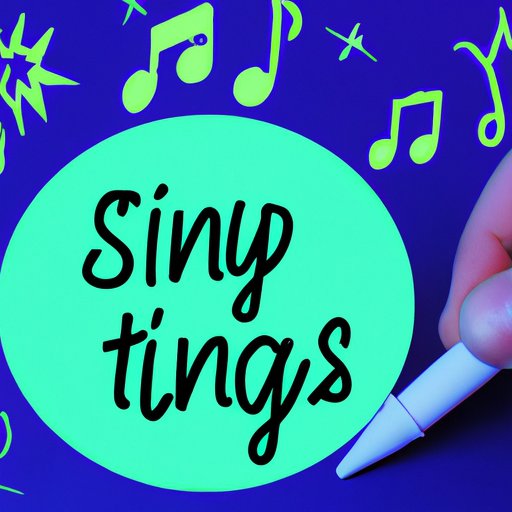
I. Introduction: Why Writing Meaningful Lyrics Matters
Song lyrics are the heart of music, creating an emotional connection with listeners and telling stories that resonate with our deepest experiences and emotions. Aspiring songwriters who want to improve their craft need to focus on writing lyrics that are both meaningful and memorable. In this article, we’ll provide tips and techniques for writing great lyrics that engage listeners and stand the test of time.
II. 7 Steps to Writing Meaningful Lyrics
Here are 7 essential steps to follow when crafting meaningful lyrics:
Step 1: Brainstorming Ideas
Start by brainstorming ideas for your song, based on personal experiences or universal themes that resonate with many listeners. Write down everything that comes to mind, without editing or censoring yourself.
Step 2: Choosing a Theme or Message
Once you have a list of ideas, choose a theme or message that fits the mood and style of your song. This will give your lyrics focus and coherence.
Step 3: Finding the Right Words and Phrases
Search for words and phrases that express your message in a powerful and memorable way. Avoid clichés and overused expressions, and experiment with different metaphors and imagery to create a unique voice for your lyrics.
Step 4: Crafting a Compelling Melody
A great melody can elevate your lyrics and bring them to life. Experiment with different chord progressions, rhythms, and harmonies to find the perfect match for your lyrics.
Step 5: Structuring the Lyrics
Structure your lyrics to create a dynamic and engaging flow. Use verses, choruses, bridges, and other elements to build tension and release, and to create a sense of progression and development throughout the song.
Step 6: Refining and Improving the Lyrics
Once you have a draft of your lyrics and melody, refine and edit them to improve the clarity, coherence, and impact of your message. Cut out any unnecessary words or phrases, and revise your metaphors and imagery to make them more evocative and relevant.
Step 7: Finalizing the Lyrics
Finally, review and polish your lyrics until they are ready to be incorporated into a finished song. Pay attention to the details, such as rhyming patterns, syllable counts, and stress patterns, to ensure that your lyrics fit seamlessly with your melody and overall musical style.
III. Unlocking Your Inner Songwriter: Tips for Writing Lyrics
Even the most talented songwriters experience writer’s block and other challenges when crafting meaningful lyrics. Here are some tips and strategies for unlocking your creativity and overcoming these obstacles:
Common Pitfalls to Avoid
- Trying too hard to be original or clever
- Using clichés or tired expressions
- Forcing rhymes or sacrificing authenticity for the sake of a rhyme
Strategies for Overcoming Writer’s Block
- Breaking down the writing process into smaller, more manageable steps
- Switching up your routine and trying new approaches to generating ideas
- Drawing inspiration from different genres of music and other forms of creative expression

IV. The Anatomy of a Great Lyric: Lessons from the Pros
Studying the lyrics of successful songwriters can help aspiring songwriters understand the qualities that make great lyrics stand out. Here are some examples and insights from some of the most impactful lyricists of all time:
Bob Dylan: Master of Metaphor and Social Commentary
Dylan’s lyrics blend intricate metaphors with political and social commentary, creating a unique voice that resonates with many listeners. His ability to create vivid imagery and evoke a wide range of emotions is a testament to the power of great lyric writing.
Joni Mitchell: Poet of Personal Experience and Emotional Truth
Mitchell’s lyrics are deeply personal and vulnerable, exploring themes of love, loss, and self-discovery. Her ability to connect with listeners on a visceral level is a testament to the power of emotional authenticity and vulnerability in songwriting.
Leonard Cohen: Master of Ambiguity and Spiritual Depth
Cohen’s lyrics explore themes of spirituality, love, and mortality, often through abstract, ambiguous language that invites multiple interpretations. His ability to unite diverse audiences around universal themes and emotions is a testament to the power of great songwriting to transcend cultural and personal boundaries.
V. The Role of Emotion in Lyrics: How to Connect with Your Audience
Creating emotional resonance with listeners is a key goal for any songwriter. Here are some tips and strategies for crafting lyrics that connect with listeners on a deep and meaningful level:
Expressing Authenticity and Vulnerability
Authenticity and vulnerability are key to creating emotional resonance with listeners. By exposing your own experiences and emotions in your lyrics, you can connect with listeners on a visceral level and create a sense of shared experience and emotion.
Creating Relatable Characters and Stories
Using characters and stories that listeners can relate to can also create emotional resonance. By tapping into universal experiences and emotions, such as love, loss, and longing, you can create lyrics that touch listeners on a personal and emotional level.
VI. Approaches to Rhyme: Finding the Right Words for Your Song
Effective use of rhyme is one of the hallmarks of great lyric writing. Here are some tips for using rhyme effectively:
Types of Rhyme: Perfect, Slant, and Internal
Perfect rhyme, in which the last syllables of two words sound identical, is the most common type of rhyme in popular music. Slant rhyme, in which the last syllables sound similar but not identical, can create a more subtle effect. Internal rhyme, in which rhyming words appear within a line rather than at the end, can create a sense of internal rhythm and flow within the lyrics.
VII. Co-Writing with Confidence: Collaboration Tips for Songwriters
Co-writing can be a powerful way to unlock creativity and improve the quality of your lyrics. Here are some tips for collaborating with other songwriters effectively:
Key Communication Strategies
- Be clear about your goals and expectations for the collaboration
- Manage creative differences and conflicts respectfully and constructively
- Set clear deadlines and expectations for feedback and revisions
VIII. Finding Inspiration: How to Overcome Writer’s Block
Writer’s block is a common challenge for any creative artist. Here are some strategies for overcoming writer’s block and finding inspiration:
Refining Your Creative Process
Break down the writing process into manageable steps, such as brainstorming, outlining, and editing. Experiment with different techniques, such as free writing or mind mapping, to find the approach that works best for you.
Drawing Inspiration from Other Sources
Listening to different types of music, reading poetry and literature, and engaging with art and nature can all provide inspiration and new perspectives for your lyrics. The key is to remain open and curious about the world around you.
IX. Conclusion: Putting it All Together
By following these tips and techniques, aspiring songwriters can improve their lyric-writing skills and create lyrics that resonate with listeners on a deep and meaningful level. Remember to stay true to your own voice and vision, and to keep writing and refining your craft every day. With persistence and dedication, you can become a great songwriter and create music that touches the hearts of millions of listeners.




